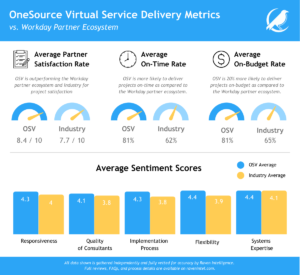As organizations identify a need to implement new software or revamp their business process to better meet goals, a new set of challenges arise outside of just identifying the transformation itself. Business leaders are suddenly tasked with identifying the goals of the projects, the ROI that it’ll bring to their company, and equally as important — identifying the right partner to help them complete the transformation.
Raven Intelligence recently had the opportunity to talk with Cameron Larkin, Client Portfolio Management Leader at OneSource Virtual (OSV), about how third-party consulting partners can bring unequalled value to an organization — along with when and where you should augment your team. (Full video at the end of this article.)
OneSource Virtual is an exclusive Workday partner offering end-to-end services for customers and an unwavering commitment to satisfaction. Larkin has been with OneSource Virtual for 7 years and is currently responsible for over 100 active deployment projects across North America.
Digital transformation or software implementation: what’s the difference?
While digital transformations and software implementations are commonly used interchangeably, the differences are vast. Software implementations typically replace back office software systems with a new software system that fits the organization’s defined needs. A digital transformation brings significant change through the implementation of a new technology that is customized to meet the business’s unique needs and is often aligned to a key organizational goal.
Larkin noted that a software deployment often lacks the “People, Process, and Technology Framework” that OneSource Virtual strives to utilize in all digital transformations.
“A systems implementation that just replaces the technology typically achieves minimal transformation. Similarly, you don’t get much People or Process improvement or uplift if the new system mimics how things were done in the old system.” – Cameron Larkin, Client Portfolio Management Leader at OneSource Virtual
While it might sound daunting at first, a digital transformation doesn’t have to be — if you pick the right partner.
Why Use a Third-Party Consultant?
Organizations who are about to embark upon a digital transformation are tasked with assembling the right teams to get the job done. Usually, there will be both internal and external resources, and those internal team members often still have other responsibilities outside of just the digital transformation.
“That’s when it makes sense to pull in third party contractors to support the legacy system activities. This way, your team can achieve optimal knowledge transfer while participating in key Workday project design decisions, legacy data conversion validation, business process testing, and training,” said Larkin.
Larkin also recognizes that becoming a more strategic HR organization begins with prioritizing money and time. By utilizing a third-party consultant, organizations can prioritize and take advantage of the knowledge and time-savings brought by using a partner.
Similar to OneSource Virtual, many third-party consultancies specialize in just one software, bringing deep levels of product expertise to the table. Other organizations come prepared with vast software knowledge of several vendors. If you’re unsure of which type of third-party consultancy is right for you, Raven Intelligence can help.

Should you use a contractor for the Project Manager role?
When assembling the resources for your team, there is typically a project manager or project lead that helps keep both teams aligned and on track. One of the biggest questions that come up in team assembly discussion is: should you use an internal team member or contractor for the project manager role?
Our conversation with Larkin made it clear that there’s pros and cons to both. On one hand, contractors bring a lot of knowledge to the table. They’re a specialist in the software that’s being implemented, so they can help ensure the implementation design meets the customer’s needs. As mentioned earlier, augmenting your internal team with external resources allows team members to still focus on their “day job” while letting a contractor lead the project.
On the other hand, the project manager role may not likely need to be full time. Using an internal resource and allocating 50% of their time towards the digital transformation could bring cost savings to the organization, rather than paying for a contractor to do this work full-time. Additionally, team members may be better suited for testing and training purposes, as they know the intricacies of the organization. Internal project leads can also promote minimal knowledge transfer, as the internal resource wouldn’t be leaving the company at the end of the organization.
“Key knowledge transfer takes place during the project (especially during testing), and it’s key that knowledge stays within the company after go-live, not disappear when a contractor leaves.” – Cameron Larkin
What Makes OneSource Virtual Different From Peers in the Workday Ecosystem?
OneSource Virtual’s unique value proposition connects People, Process, and Technology in their unique framework for implementations. From the people perspective, OSV has significant tenure and experience within Workday deployments within their team. Within the process portion of their framework, the OSV team has enhanced the standard Workday deployment methodology with several critical processes, such as their Catalyst process that supercharges the planning/kickoff phase.
From a technology perspective, OSV brings tools to the table that helps reduce project time and cost while increasing the quality of data and configuration. All of these things combined, plus being one of the most tenured Workday partners in the ecosystem, OneSource Virtual brings a unique combination of talent and experience to their projects.
“The implementation team at OSV was an excellent partner. The Implementation specialists assigned to our project took the time to understand our business and how we could configure the system to fit within our processes rather than pushing us into new processes to fit within a system.”
– Project Leader, North America, Advertising, Workday HCM

